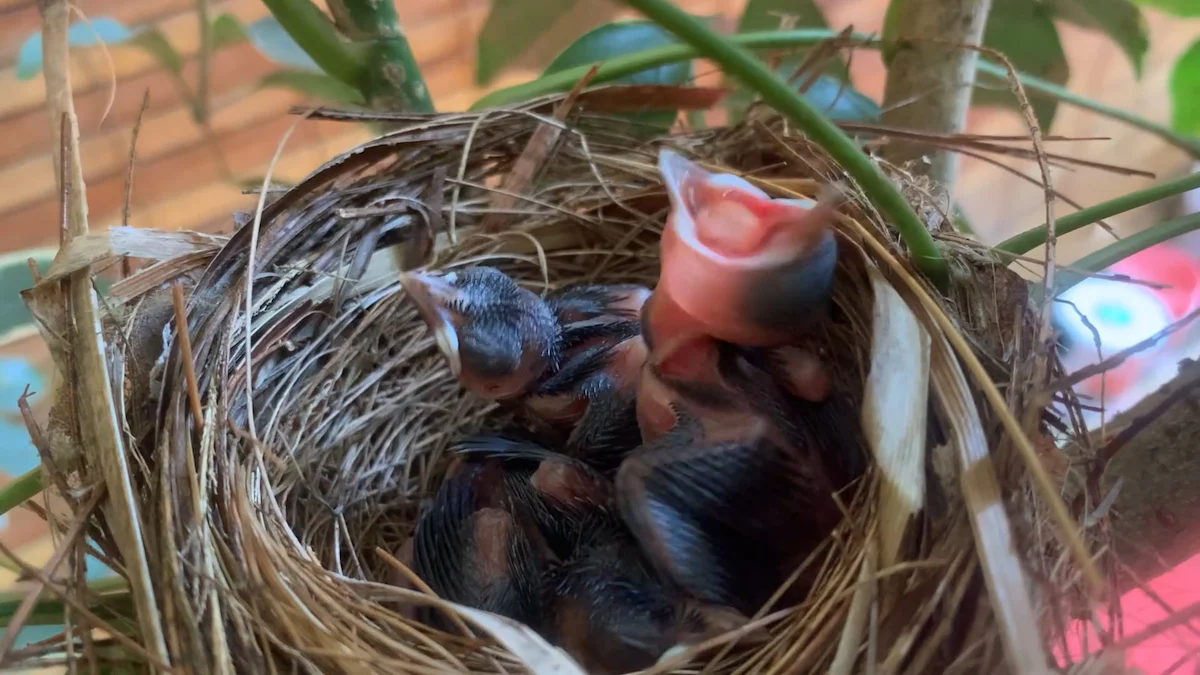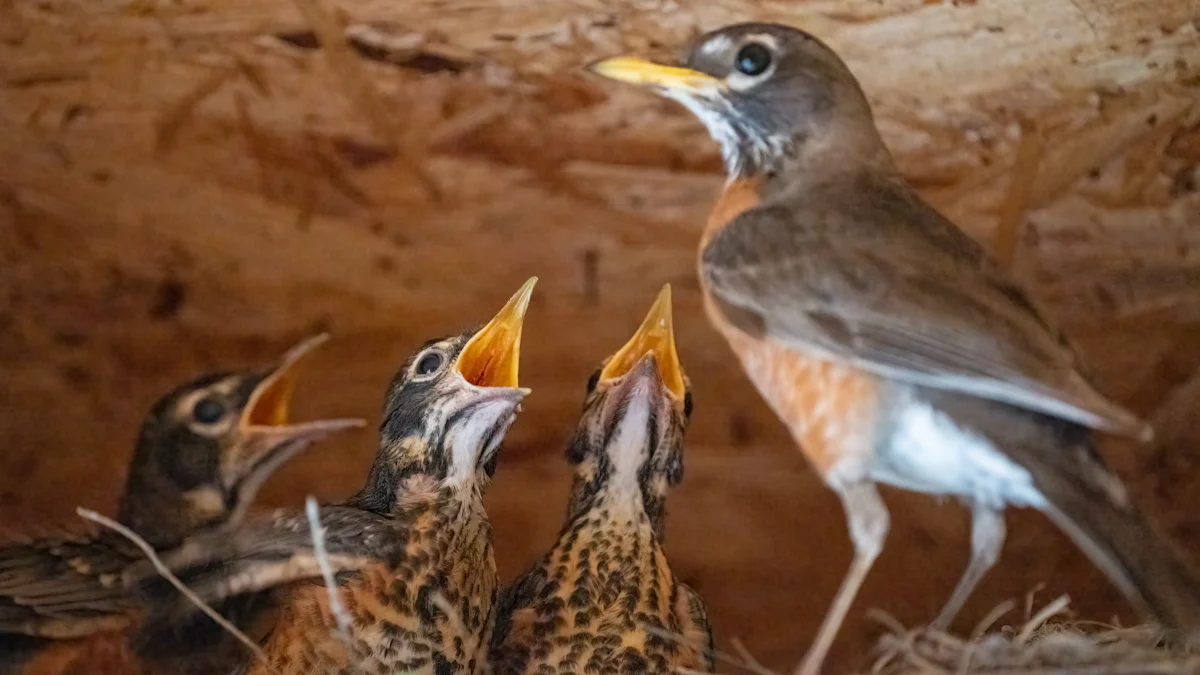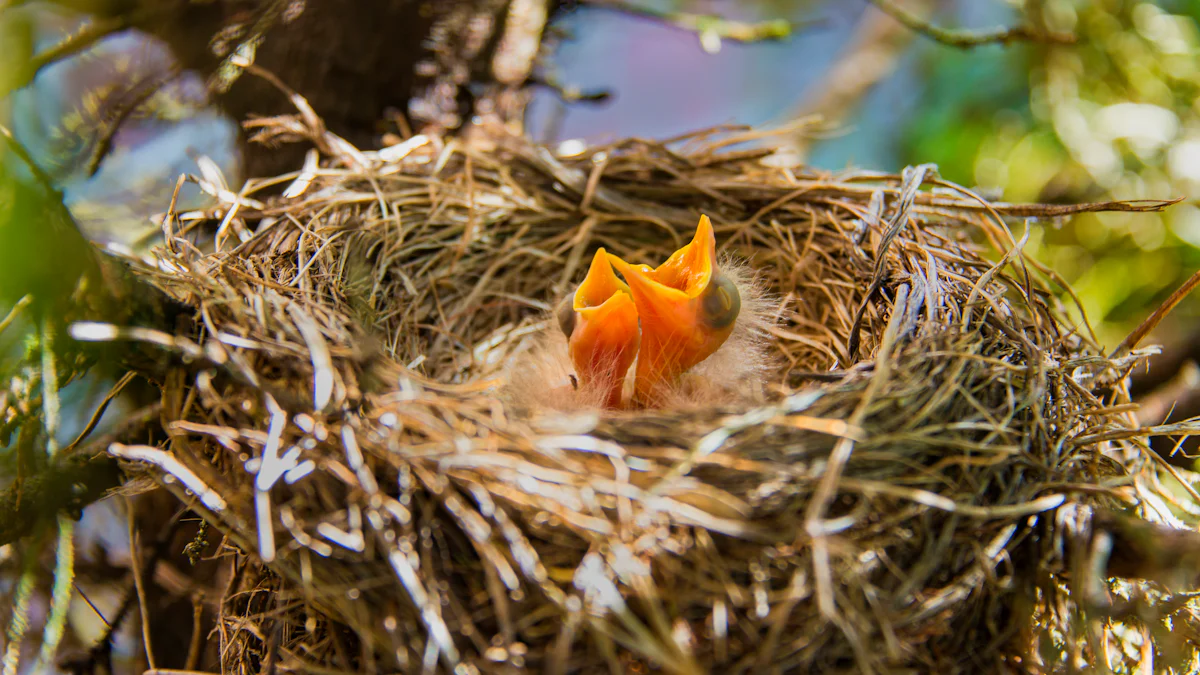
Imagine your hatchlings eagerly munching on mealworms, a delightful treat that packs a punch of nutrition. Mealworms offer a fantastic source of protein, with levels ranging from 36.3% to 74.1% on a dry matter basis. This makes them an excellent addition to your hatchlings’ diet. You can introduce nestlings mealworms at the right time and with proper preparation. These little critters not only provide essential nutrients but also help your young ones develop their feeding skills. So, get ready to watch your hatchlings thrive with this tasty and nutritious snack!
Key Takeaways
- Mealworms are a highly nutritious food source for hatchlings, providing essential protein and nutrients crucial for their growth.
- Use feeding dishes with low sides and tweezers or tongs to safely serve mealworms, ensuring a clean and efficient feeding process.
- Introduce mealworms gradually, starting with small sizes for younger hatchlings and increasing as they grow, to support their developing feeding skills.
- Complement mealworms with a variety of other foods, such as fruits and vegetables, to ensure a balanced diet and keep mealtime interesting.
- Establish a consistent feeding schedule to help hatchlings develop a routine, which can reduce stress and promote healthy eating habits.
- Monitor your hatchlings’ health closely for signs of overfeeding or allergies, and adjust their diet as needed to maintain their well-being.
- Always prioritize hygiene by washing hands and cleaning feeding tools to create a safe feeding environment for your hatchlings.
Necessary Tools and Materials for Feeding

Feeding your hatchlings mealworms requires a few essential tools and materials. These items ensure that the feeding process is smooth and safe for your little ones. Let’s dive into what you’ll need!
Tools Required
Feeding Dishes
Feeding dishes are a must-have for serving mealworms to hatchlings. They keep the mealworms contained, making it easier for the hatchlings to eat. Choose dishes with low sides so the mealworms can’t escape. This setup allows your hatchlings to focus on their meal without any distractions.
Tweezers or Tongs
Tweezers or tongs are your best friends when handling mealworms. They help you pick up the mealworms without touching them directly. This tool is especially useful if you’re a bit squeamish about handling live mealworms. Plus, it ensures that the mealworms are placed precisely where you want them, minimizing mess and maximizing feeding efficiency.
Materials Needed
Fresh Mealworms
Fresh mealworms are the star of the show. They provide a high protein content, which is crucial for the growth and development of hatchlings. Live mealworms are preferable as they are easier for young birds to digest. Make sure to source your mealworms from a reputable supplier to ensure they are healthy and nutritious.
Nutritional Supplements
While mealworms are a great source of protein, they might not provide all the nutrients your hatchlings need. Nutritional supplements can fill in the gaps. Consider adding vitamins and minerals to the mealworms to create a balanced diet. This approach ensures that your hatchlings receive all the essential nutrients they need to thrive.
With these tools and materials at your disposal, you’re well-equipped to introduce mealworms to your hatchlings. Happy feeding!
Detailed Feeding Instructions Based on Age
Feeding Hatchlings Under Two Weeks
Preparation of Mealworms
Your tiny hatchlings are ready for their first taste of mealworms! Start by selecting the smallest mealworms available. These little critters should be fresh and lively, ensuring they provide the maximum nutritional punch. Before serving, you might want to dust them with a fine layer of calcium powder. This step boosts their nutritional value, giving your hatchlings a healthy start.
Feeding Techniques for Young Hatchlings
Feeding these young ones requires a gentle touch. Use tweezers or tongs to offer the mealworms directly to the hatchlings. This method helps them focus on the meal without getting distracted. You might notice some hesitation at first, but with patience, they’ll soon get the hang of it. Remember, it’s all about creating a positive feeding experience!
Feeding Hatchlings Over Two Weeks
Adjusting Mealworm Size
As your hatchlings grow, so does their appetite! At this stage, you can gradually increase the size of the mealworms. Larger mealworms provide more protein, which is essential for their rapid growth. Keep an eye on their eating habits to ensure they’re comfortable with the new size. If they struggle, consider cutting the mealworms into smaller pieces.
Introducing Variety in Diet
Variety is the spice of life, even for hatchlings! While mealworms are a fantastic source of protein, it’s important to introduce other foods to their diet. Consider adding small amounts of fruits, vegetables, or other insects. This approach ensures they receive a balanced diet, packed with essential vitamins and minerals. Plus, it keeps mealtime exciting and engaging for your growing hatchlings!
Nutritional Benefits and Considerations

Mealworms are not just a tasty treat for your hatchlings; they pack a nutritional punch that can support their growth and development. Let’s explore the nutritional profile of these little critters and how you can ensure a balanced diet for your feathered friends.
Nutritional Profile of Mealworms
Mealworms are like tiny powerhouses of nutrition. They offer a rich source of proteins, essential amino acids, and fatty acids. These nutrients are vital for the healthy growth of your hatchlings. Mealworms also contain a variety of minerals and vitamins, making them a well-rounded food choice.
Protein Content
Protein is the building block of life, and mealworms are loaded with it. They provide a high protein content, which is crucial for the rapid growth and development of nestlings mealworms. This protein helps in building strong muscles and tissues, ensuring your hatchlings grow up healthy and strong.
Essential Vitamins and Minerals
Mealworms are not just about protein; they also offer essential vitamins and minerals. These include vitamins like B12 and minerals such as iron and zinc. These nutrients play a significant role in boosting the immune system and supporting overall health. By including mealworms in their diet, you give your hatchlings a head start in life.
Considerations for a Balanced Diet
While mealworms are nutritious, it’s important to ensure your hatchlings receive a balanced diet. Here’s how you can complement mealworms with other foods and monitor their health.
Complementing Mealworms with Other Foods
Variety is key to a balanced diet. While nestlings mealworms are a fantastic source of protein, you should introduce other foods to their diet. Consider adding small amounts of fruits, vegetables, or other insects. This approach ensures they receive a wide range of nutrients, keeping their diet exciting and nutritious.
Monitoring Hatchling Health
Keeping an eye on your hatchlings’ health is crucial. Watch for any signs of nutritional deficiencies or health issues. Regularly check their weight and growth patterns. If you notice any problems, adjust their diet accordingly. By monitoring their health, you can ensure they thrive and develop into strong, healthy birds.
By understanding the nutritional benefits of mealworms and considering a balanced diet, you can provide your hatchlings with the best start in life. Happy feeding!
Feeding Frequency and Schedule
Feeding your hatchlings the right amount of nestlings mealworms at the right times is crucial for their healthy growth. Let’s explore how often you should feed them and how to create a schedule that suits their needs.
Recommended Feeding Frequency
Daily Feeding Guidelines
You should feed your hatchlings daily to ensure they receive enough nutrients for their rapid growth. Start with small portions of nestlings mealworms, gradually increasing the amount as they grow. This approach helps them develop strong muscles and healthy feathers. Remember, consistency is key to maintaining their energy levels and supporting their development.
Adjustments Based on Growth and Activity
As your hatchlings grow, their activity levels will change. More active birds may require additional feedings to meet their energy needs. Observe their behavior and adjust the feeding frequency accordingly. If they seem more energetic or are growing quickly, consider offering extra mealworms to support their increased nutritional demands.
Creating a Feeding Schedule
Consistency in Feeding Times
Establishing a consistent feeding schedule helps your hatchlings develop a routine. Feed them at the same times each day to create a sense of stability. This consistency not only aids in digestion but also helps them anticipate mealtime, reducing stress and promoting a healthy appetite.
Observing Hatchling Behavior
Pay close attention to your hatchlings’ behavior during feeding times. Notice how they respond to the mealworms and adjust the schedule if necessary. If they seem disinterested or leave food uneaten, it might be time to tweak the timing or portion sizes. By observing their reactions, you can fine-tune their feeding schedule to better suit their needs.
By following these guidelines, you can ensure your hatchlings receive the right amount of nutrition at the right times. This careful planning will help them grow into strong, healthy birds, ready to take on the world!
Tips and Warnings for Safe Feeding Practices
Feeding mealworms to your hatchlings can be a rewarding experience, but it’s important to follow safe practices. Let’s explore some tips and warnings to ensure a healthy and enjoyable feeding time for your feathered friends.
Safe Handling of Mealworms
Handling mealworms properly is crucial for maintaining hygiene and preventing overfeeding. Here are some tips to keep in mind:
Hygiene Practices
-
Wash Your Hands: Always wash your hands before and after handling mealworms. This simple step helps prevent the spread of germs and keeps your hatchlings safe.
-
Clean Feeding Tools: Regularly clean feeding dishes, tweezers, or tongs. Use warm soapy water to remove any residue or bacteria. Clean tools ensure a safe feeding environment for your hatchlings.
-
Store Mealworms Properly: Keep mealworms in a cool, dry place. Proper storage prevents spoilage and maintains their nutritional value.
Avoiding Overfeeding
-
Monitor Portion Sizes: Start with small portions and gradually increase as your hatchlings grow. Overfeeding can lead to obesity and health issues.
-
Observe Eating Habits: Pay attention to how much your hatchlings eat. If they leave food uneaten, reduce the portion size. This practice helps prevent waste and ensures they receive the right amount of nutrition.
Recognizing Signs of Overfeeding or Allergies
Understanding the signs of overfeeding or allergies can help you address any issues promptly. Here’s what to watch for:
Symptoms to Watch For
-
Lethargy: If your hatchlings seem unusually tired or inactive, it might be a sign of overfeeding. Adjust their diet accordingly.
-
Digestive Issues: Look for signs of diarrhea or vomiting. These symptoms could indicate an allergy or intolerance to mealworms.
-
Skin Reactions: Watch for any unusual skin reactions, such as redness or swelling. According to Broekman et al., exposure to mealworms can induce primary sensitization and may lead to food allergies in some cases.
Steps to Take if Issues Arise
-
Consult a Veterinarian: If you notice any concerning symptoms, consult a veterinarian. They can provide guidance on dietary adjustments and allergy management.
-
Adjust the Diet: If overfeeding is the issue, reduce the portion size or frequency of mealworm feedings. Introduce other foods to ensure a balanced diet.
-
Monitor Health: Keep a close eye on your hatchlings’ health and behavior. Regular monitoring helps you catch any issues early and make necessary changes.
By following these tips and warnings, you can create a safe and enjoyable feeding experience for your hatchlings. Remember, a little care goes a long way in ensuring their health and happiness!
You’ve now got the scoop on safely introducing mealworms to your hatchlings. Remember, a consistent feeding schedule can make your little ones more eager to try new foods. By offering a variety of nutrient-rich options, you help them build a positive relationship with food. Keep an eye on their health and consult a healthcare provider if you’re unsure about feeding guidelines. With these tips, your hatchlings will grow strong and healthy, ready to spread their wings!
FAQ
What is the importance of feeding baby mealworms properly?
Feeding baby mealworms properly is crucial for their growth and development. By providing a balanced diet of grains, fresh fruits, vegetables, and supplemental protein, you ensure they thrive. This not only enhances the quality of the mealworms but also supports a sustainable breeding operation. As demand for mealworms grows, proper nutrition becomes key to maintaining a successful breeding program.
What is the ideal diet for baby mealworms?
Mealworms, the larvae of the darkling beetle, are a popular protein source for animals like reptiles and birds. To ensure healthy growth, feed them a diet rich in grains, fresh produce, and protein supplements. This comprehensive diet helps them thrive and supports their development into mature beetles.
Can hatchlings eat mealworms right away?
Hatchlings can eat mealworms, but timing and preparation are essential. Start with small, fresh mealworms and gradually introduce them as the hatchlings grow. This approach ensures they receive the necessary nutrients without overwhelming their digestive systems.
How do I know if my hatchlings are ready for mealworms?
Observe your hatchlings’ behavior and growth. If they show interest in solid foods and have developed enough to handle small mealworms, it’s a good time to introduce them. Always start with small portions and monitor their response.
How often should I feed mealworms to hatchlings?
Feed hatchlings daily, adjusting the amount as they grow. Consistent feeding helps maintain their energy levels and supports healthy development. Monitor their activity and growth to determine if additional feedings are necessary.
Are there any risks associated with feeding mealworms to hatchlings?
While mealworms are nutritious, overfeeding can lead to health issues. Watch for signs of overfeeding, such as lethargy or digestive problems. If you notice any adverse reactions, consult a veterinarian and adjust their diet accordingly.
Can mealworms be the sole food source for hatchlings?
Mealworms should not be the sole food source. They provide excellent protein but lack some essential nutrients. Complement their diet with fruits, vegetables, and other insects to ensure a balanced intake of vitamins and minerals.
How do I handle mealworms safely?
Use tweezers or tongs to handle mealworms, minimizing direct contact. Wash your hands before and after handling them to maintain hygiene. Clean feeding tools regularly to prevent contamination.
What should I do if my hatchlings show signs of allergies?
If you notice symptoms like skin reactions or digestive issues, consult a veterinarian immediately. They can provide guidance on dietary adjustments and allergy management to ensure your hatchlings’ well-being.
How can I make feeding mealworms more engaging for hatchlings?
Introduce variety by mixing mealworms with other foods. This keeps mealtime exciting and encourages hatchlings to explore different textures and flavors. Observing their preferences can help tailor their diet to their liking.


